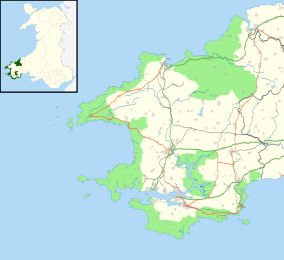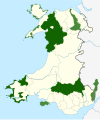Pembrokeshire Coast National Park
| Pembrokeshire Coast National Park | |
|---|---|
| Parc Cenedlaethol Arfordir Penfro (Welsh) | |
IUCN category V (protected landscape/seascape) | |
 Area of Porth Coch Mawr and Porth y Ffynnon, near Porthclais | |
 Location of the national park in Pembrokeshire, Wales | |
| Location | Pembrokeshire, Wales, United Kingdom |
| Area | 629 km2 (243 sq mi) |
| Established | 1952 |
| Website | www |
| UK National Parks |
|---|
| Parentheses denotes the year. An area with ‡ has similar status to a UK National Park. Areas marked † are proposed. |
Pembrokeshire Coast National Park (
It was established as a National Park in 1952. It is one of the three National parks of Wales, the others being the Brecon Beacons (Bannau Brycheiniog) and Snowdonia (Eryri). It is the only national park in the United Kingdom to consist largely of coastal landscapes.[1][2]
Landscape
The National Park has a varied landscape of rugged
The

The National Park includes many sites (such as
In 2011, National Geographic Traveler magazine voted Pembrokeshire the second best coastal destination in the world for sustainable tourism.[5][6][7]
In January 2016 the Authority launched the "Changing Coasts" project to document the way the coastline has changed as a result of recent winter storms; the project invites visitors to submit photographs taken (at any time of day) from fixed points; a pilot study will be carried out at Abereiddy.[8]
Pembrokeshire Coast Path
The Pembrokeshire Coast Path is a designated
The southern end of the path is at
Administration
The Park is managed by Pembrokeshire Coast National Park Authority, which has around 150 staff and a committee of 18 members. The Authority's purposes are to conserve and enhance the National Park, and encourage the public to enjoy and understand it. In pursuing these purposes, the authority has a duty to foster the social and economic well-being of the communities within its boundaries. Its offices are in Pembroke Dock.[16] The Chief Executive is Tegryn Jones.[17]
The Authority also manages the entire length of the Pembrokeshire Coast Path, a 186-mile (299 km) national trail which lies almost entirely within the Pembrokeshire Coast National Park.
In light of renaming of the other two Welsh national parks, the authority stated it plans to retains both its English and Welsh name in April 2023.[18]
Beaches

Over the years Pembrokeshire's beaches, all of which lie in the National Park, have been awarded many International
Beaches in the park include:
See also
- UK coastline
- Castlemartin Training Area
References
- ^ "Welsh Government: Visit Wales". Retrieved 3 July 2020.
- ^ "Pembrokeshire Coast National Park, Wales". National Geographic. 2 November 2017. Retrieved 3 July 2020.
- ^ "Stack Rocks/St Govan's". BBC Wales. Retrieved 5 February 2011.
- ^ "Pembrokeshire Coast National Park". Retrieved 3 July 2020.
- ^ www.NationalTrails.co.uk - news article Archived 2011-06-28 at the Wayback Machine
- ^ "Welsh Wonders: Uncovering Hidden Gems – Europe Guidebook". Retrieved 3 April 2023.
- ^ www.WalesOnline.co.uk - Accolade of being one of world's top trails
- ^ "Pembrokeshire Changing Coasts photography project launched". BBC. 31 January 2016. Retrieved 1 February 2016.
- ^ "Pembrokeshire Coast Path". National Trails. Archived from the original on 17 August 2013. Retrieved 14 August 2013.
- ^ "Coast Path Marker". Pembrokeshire Coastal Photography. Retrieved 29 May 2014.
- ISBN 978-1845137823.
- ^ "Pembrokeshire Coast Path: Newport to St Dogmaels". visitpembrokeshire.com. Archived from the original on 18 June 2013. Retrieved 14 August 2013.
- ^ "St Dogmaels to Newport (Town) 16 miles, (25.7 Kilometres)". Planning a Trip. National Trails. Retrieved 14 August 2013.
- ^ "All-Wales coast path moves a step closer at St Dogmaels". BBC News South West Wales. 21 February 2011. Retrieved 14 August 2013.
- ^ "All-Wales coast path nears completion". BBC News Wales. 17 October 2011. Retrieved 14 August 2013.
- ^ "About the National Park Authority". Pembrokeshire Coast National Park Authority. Retrieved 7 August 2021.
- ^ "Pembrokeshire crackdown on 'wild camping' in car parks". BBC News. 7 August 2020. Retrieved 7 August 2021.
- ^ "Brecon Beacons: Park to use Welsh name Bannau Brycheiniog". BBC News. 17 April 2023. Retrieved 17 April 2023.
- ^ "Blue flags fly over Pembrokeshire beaches". Western Telegraph. 13 June 2014. Retrieved 14 June 2014.
- ^ VisitWales.co.uk - Pembrokeshire beaches Archived 2012-01-06 at the Wayback Machine Retrieved 19 December 2011
- ^ Pembrokeshire (Annual Guide), Pembrokeshire Tourism, 2011


